 W
WThe Airco DH.3 was a British bomber aircraft of the First World War. The DH.3 was designed in 1916 as a long-range day bomber by Geoffrey de Havilland, chief designer at the Aircraft Manufacturing Company. It was a large biplane with wide-span three-bay wings, slender fuselage, and a curved rudder. It was powered by two 120 hp (89 kW) Beardmore engines, mounted as pushers between the wings. In addition to tailskid landing gear, two wheels were placed beneath the nose to prevent bumping.
 W
WThe Airco DH.4 was a British two-seat biplane day bomber of the First World War. It was designed by Geoffrey de Havilland for Airco, and was the first British two-seat light day-bomber to have an effective defensive armament.
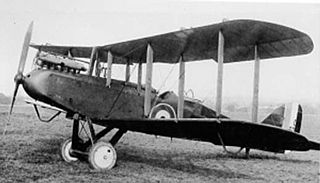 W
WThe Airco DH.9 – also known after 1920 as the de Havilland DH.9 – was a British single-engined biplane bomber developed and deployed during the First World War.
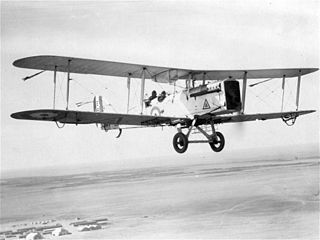 W
WThe Airco DH.9A was a British single-engined light bomber designed and first used shortly before the end of the First World War. It was a development of the unsuccessful Airco DH.9 bomber, featuring a strengthened structure and, crucially, replacing the under-powered and unreliable inline 6-cylinder Siddeley Puma engine of the DH.9 with the American V-12 Liberty engine.
 W
WThe Airco DH.10 Amiens was a British twin-engined medium bomber designed and built towards the end of the First World War. It served briefly postwar with the RAF.
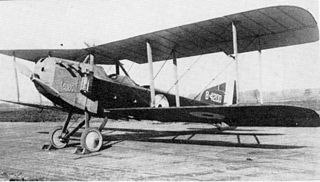 W
WThe Armstrong Whitworth F.K.8 was a British two-seat general-purpose biplane built by Armstrong Whitworth during the First World War. The type served alongside the better known R.E.8 until the end of the war, at which point 694 F.K.8s remained on RAF charge.
 W
WThe Avro 504 was a First World War biplane aircraft made by the Avro aircraft company and under licence by others. Production during the war totalled 8,970 and continued for almost 20 years, making it the most-produced aircraft of any kind that served in any military capacity during the First World War. More than 10,000 were built from 1913 until production ended in 1932.
 W
WThe Avro 523 Pike was a British multi-role combat aircraft of the First World War that did not progress past the prototype stage. It was intended to provide the Royal Naval Air Service with an anti-Zeppelin fighter that was also capable of long-range reconnaissance and bombing.
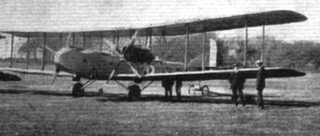 W
WThe Avro 529 was a twin-engined biplane long-range bomber of the First World War. Two prototypes were built but no production ensued.
 W
WThe Avro 533 Manchester was a First World War-era twin-engine biplane photo-reconnaissance and bomber aircraft designed and manufactured by Avro.
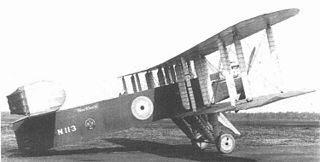 W
WThe Blackburn Blackburd was a British prototype single-engine torpedo bomber developed by Blackburn Aircraft in 1918 as a replacement for the Sopwith Cuckoo. It was unsuccessful, only three being built.
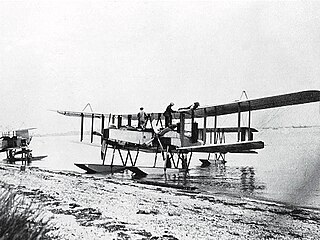 W
WThe Blackburn G.P seaplane,, was a British twin-engine reconnaissance torpedo floatplane of the First World War, built by the Blackburn Aeroplane and Motor Co Ltd.
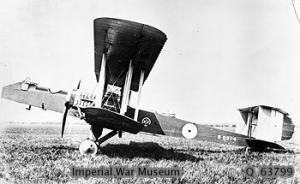 W
WThe Blackburn R.T.1 Kangaroo was a British twin-engine reconnaissance torpedo biplane of the First World War, built by Blackburn Aircraft.
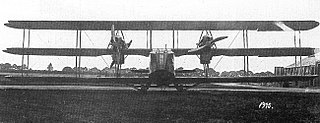 W
WThe Bristol Braemar was a British heavy bomber aircraft developed at the end of the First World War for the Royal Air Force. Only two prototypes were constructed.
 W
WThe Bristol T.B.8, or Bristol-Coanda T.B.8 was an early British biplane built by the Bristol Aeroplane Company and designed by the Romanian Henri Coandă. Fifty four Bristol T.B.8s were built, being mainly used as a trainer. A small number of Bristol T.B.8s were briefly used as bombers at the start of the World War I by the Royal Naval Air Service.
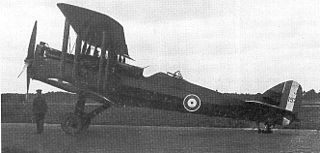 W
WThe de Havilland DH.14 Okapi was a British two-seat day bomber of the 1910s built by de Havilland. The aircraft was designed as an Airco DH.4 and DH.9 replacement, but it never entered production.
 W
WThe Airco DH.11 was a British twin-engined biplane bomber which was designed to replace the earlier Airco DH.10 bomber. It was designed to use the unsuccessful ABC Dragonfly engine and was abandoned after the first prototype was built.
 W
WThe Handley Page Type O was a biplane bomber used by Britain during the First World War. When built, the Type O was the largest aircraft that had been built in the UK and one of the largest in the world. There were two main variants, the Handley Page O/100 (H.P.11) and the Handley Page O/400 (H.P.12).
 W
WThe Kennedy Giant was a British biplane heavy bomber designed by Kennedy Aeroplanes Ltd. during the First World War. The design was an imitation of works by Igor Sikorsky, with whom the owner of Kennedy Aeroplanes Ltd., C. J. H. Mackenzie-Kennedy, had ostensibly worked prior to setting up the company. The aeroplane was a notorious failure; its size meant that construction had to take place in an open field as none of the hangars near Hayes, Middlesex, where the prototype was assembled, were large enough to house it. For its weight, the aircraft's four engines were inadequate, and the resulting under-powered aircraft could only fly in a straight line once airborne.
 W
WThe Martinsyde G.100 "Elephant" and the G.102 were British fighter bomber aircraft of the First World War built by Martinsyde. The type gained the name "Elephant" from its relatively large size and lack of manoeuvrability. The G.102 differed from the G.100 only in having a more powerful engine.
 W
WBetween 1911 and 1914, the Royal Aircraft Factory used the F.E.2 designation for three quite different aircraft that shared only a common "Farman" pusher biplane layout.
 W
WThe Royal Aircraft Factory R.E.5 was a British two-seat reconnaissance and artillery observation biplane designed and built by the Royal Aircraft Factory for the Royal Flying Corps.
 W
WThe Royal Aircraft Factory R.E.7 was a British two-seat light bomber and reconnaissance biplane designed by the Royal Aircraft Factory and built under contracts by the Coventry Ordnance Works, Austin, Napier and Siddeley-Deasy for the Royal Flying Corps.
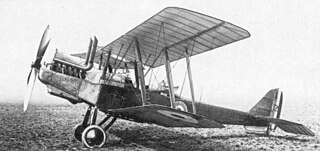 W
WThe Royal Aircraft Factory R.E.8 was a British two-seat biplane reconnaissance and bomber aircraft of the First World War designed and produced at the Royal Aircraft Factory. It was also built under contract by Austin Motors, Daimler, Standard Motors, Siddeley-Deasy and the Coventry Ordnance Works.
 W
WThe Short Type 166 was a 1910s British two-seat reconnaissance, bombing and torpedo-carrying folder seaplane, designed by Short Brothers.
 W
WThe Short Bomber was a British two-seat long-range reconnaissance, bombing and torpedo-carrying aircraft designed by Short Brothers as a land-based development of the very successful Short Type 184.
 W
WThe Short N.1B Shirl was a British single-seat biplane,intended to carry heavy torpedoes from early aircraft carriers late in World War I. It met its specifications but planned production was ended with the Armistice of 1918. The design was developed further for an attempt to cross the Atlantic nonstop for the first time, but this was not successful.
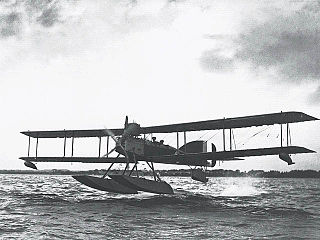 W
WThe Short Admiralty Type 184, often called the Short 225 after the power rating of the engine first fitted, was a British two-seat reconnaissance, bombing and torpedo carrying folding-wing seaplane designed by Horace Short of Short Brothers. It was first flown in 1915 and remained in service until after the armistice in 1918. A Short 184 was the first aircraft to sink a ship using a torpedo, and another was the only British aircraft to take part in the Battle of Jutland.
 W
WThe Short Type 320, also known as the Short Admiralty Type 320, was a British two-seat reconnaissance, bombing and torpedo-carrying "folder" seaplane of the First World War.
 W
WThe Sopwith 1 1⁄2 Strutter was a British single- or two-seat multi-role biplane aircraft of the First World War. It was significant as the first British two-seat tractor fighter and the first British aircraft to enter service with a synchronised machine gun. It was given the name 1 1⁄2 Strutter because of the long and short cabane struts that supported the top wing. The type was operated by both British air services and was in widespread but lacklustre service with the French Aéronautique Militaire.
 W
WThe Sopwith Baby was a British single-seat tractor seaplane used by the Royal Naval Air Service (RNAS) from 1915.
 W
WThe Sopwith T.1 Cuckoo was a British biplane torpedo bomber used by the Royal Naval Air Service (RNAS), and its successor organization, the Royal Air Force (RAF). The T.1 was the first landplane specifically designed for carrier operations, but it was completed too late for service in the First World War. After the Armistice, the T.1 was named the Cuckoo.
 W
WThe Sopwith 2B2 Rhino was a British two-seat triplane bomber designed and built by Sopwith Aviation Company as a private venture. The Rhino was powered by a 230 hp (172 kW) Beardmore Halford Pullinger inline piston engine. Only two aircraft were built and the type did not enter production.
 W
WThe Sopwith Admiralty Type 860 was a 1910s British biplane seaplane torpedo bomber designed and built for the Admiralty by the Sopwith Aviation Company.
 W
WThe Tarrant Tabor was a British triplane bomber designed towards the end of the First World War and was briefly the world's largest aircraft. It crashed, with fatalities, on its first flight.
 W
WThe Vickers Vimy was a British heavy bomber aircraft developed and manufactured by Vickers Limited. Developed during the latter stages of the First World War to equip the Royal Flying Corps (RFC), the Vimy was designed by Reginald Kirshaw "Rex" Pierson, Vickers' chief designer.